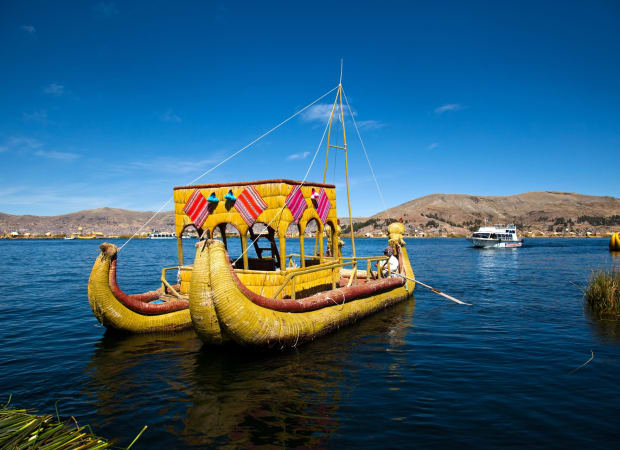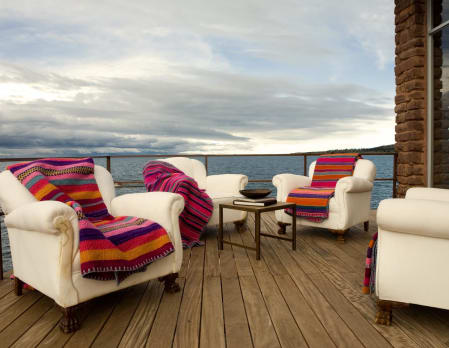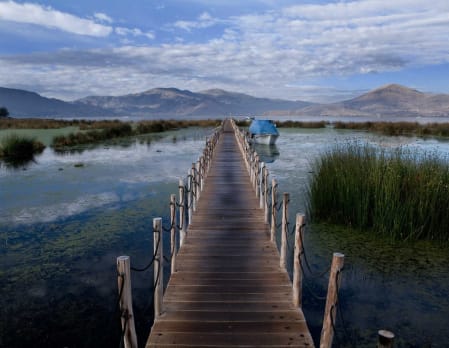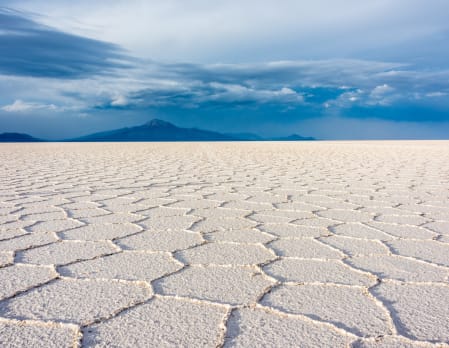Lake Titicaca Tours
The mighty Lake Titicaca straddles the border of Bolivia and Peru and is the world’s highest navigable lake, at 3,830m above sea level. The snow-capped Andes, often cloaked in an ethereal mist, are a spectacular backdrop against the electric blue waters.

The Andean people refer to the lake as "The Sacred Lake" and legend has it that the first Inca rose from its depths and went out to found the Inca Empire. Lake Titicaca is dotted with dozens of islands waiting to be explored. The best known include the man-made floating reed islands of the Uro Indians and Taquile, home to spectacular pre-Inca ruins where traditional beliefs and ways of life still predominate. You get to Lake Titicaca on the Peruvian side from Puno, Peru’s folkloric centre and altiplano capital. The spectacular journey from Puno to La Paz (Bolivia), can be done in a day by catamaran, or you can savour the experience by spending the night on Sun Island on Lake Titicaca.
"An unusual part of Peru is Lake Titicaca. This is off the beaten path, not something that everyone does when they go to Peru. You can go by flight or by taking a 10 hour train. Taking the train is a very different experience that allows you to really see the full landscape of Peru. The hotel Titilaka is an experience in itself and the best way to experience the lake. Here you can have a unique and non touristic tour of the floating islands. This is where locals have created their own pieces of land using piled up reeds right on the lake! As they are constantly floating they must add in reeds monthly to stay afloat. "
Julie Norton, Travel Specialist






Titilaka
Puno & Lake Titicaca, Peru
Titilaka is a luxurious all suite lodge and the most exclusive hotel in the region, set on a secluded private peninsula on the shores of Peru's famous Lake Titicaca, the world's highest navigable lake which is surrounded by breathtaking Andean landscapes.

Casa Andina Premium Puno
Puno & Lake Titicaca, Peru
The Casa Andina Premium Puno is conveniently located right on the shores of Lake Titicaca on the outskirts of the city of Puno. Like other Casa Andinas across Peru, the hotel features good facilities and affordable accommodation.

GHL Hotel Lago Titicaca
Puno & Lake Titicaca
GHL Hotel Lago Titicaca is conveniently located on the shores of Lake Titicaca. Set on the outskirts of the city of Puno, the hotel is ideally located for wonderful views of the lake and exploring the region and the Uros reed Islands nearby.

Epic Peru & Bolivia
Lima, Sacred Valley, Machu Picchu, Cusco, Lake Titicaca, La Paz & Uyuni
Experience the best of two incredible countries: Peru and Bolivia. The tour takes in Lake Titicaca's floating reed islands and includes a private guided trip to the unforgettable Machu Picchu. You'll also stay in glamping domes at the breathtaking Uyuni salt flat, where pristine reflections of the sky create ethereal landscapes with no horizon.
GBP £9,000 pp

Limitless Peru
Sacred Valley, Machu Picchu, Cuzco, Lake Titicaca, Lima & the Amazon
Access the inaccessible on our exclusive Limitless Peru tour. Explore the country's highlights by day and relax in sumptuous properties by night. Admire the dramatic Andean scenery and the breathtaking Machu Picchu. Take in Lake Titicaca, Cusco and the Sacred Valley before finishing with a luxurious Amazon cruise aboard the Aqua Nera.











